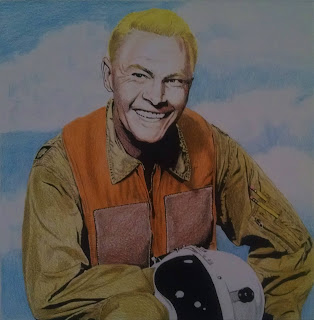LEGENDARY HEROES #50
STEVE CANYON
By 1946 cartoonist Milton Caniff had achieved worldwide recognition with his "Terry and the Pirates" comic strip, but he wasn't happy with his situation because the Chicago Tribune who syndicated the strip owned all the rights to the character. When Marshall Field of the Chicago Sun-Times approached the top cartoonists of the Trib with an attractive offer of character ownership and hefty contracts if they came to work for him, Caniff jumped ship. (Chester Gould of "Dick Tracy" and Harold Gray of "Little Orphan Annie" were among those approached, but decided to stay.) Caniff's last "Terry" strip appeared in December 1946 and a few weeks later his new strip, "Steve Canyon" debuted on January 13, 1947. Field Enterprises syndicated the strip through King Features which actually distributed it to newspapers. Due to Caniff's popularity with "Terry and the Pirates", his new comic debuted in 168 newspapers, an astounding number when one considers that many popular strips had to work years just to attain that goal. "Steve Canyon" was an instant success.
In the story Steve is an easygoing adventurer, a veteran of the last war who now runs his own air-transport business, which takes him to many exciting and exotic locales. In the early stories Steve acquired a sometime-sidekick in the form of an eccentric, bewhiskered, millionaire-adventurer named Happy Easter. His romantic interest was a redheaded businesswoman named Copper Calhoun, sort of a Capitalist version of the popular Dragon Lady that Caniff created in "Terry and the Pirates". But Steve's long-term love interest was Calhoun's private secretary Summer Olson whom he married on April 25, 1970. Like he did in "Terry", Caniff populated the "Canyon" strip with lots of female and femme fatale characters like Madame Lynx and Miss Mizzou. During the Korean War, Steve returned to the Air Force and would remain there for the remainder of the comic strip's run, eventually becoming part of Air Force intelligence and involved in lots of Cold War intrigue.
The strip was enormously popular and Caniff and Canyon appeared on the covers of Time and Newsweek, along with feature articles in Life. In 1952 Caniff hired Dick Rockwell to be his assistant. Dick was the nephew of Norman Rockwell and continued as Caniff's assistant until the very end when Caniff died on May 3, 1988. Since Caniff owned the rights to "Steve Canyon", he had decided long before that when he died or retired that the comic strip would come to an end, which happened on June 4, 1988 with a tribute to Caniff - one panel was drawn by Bill Mauldin, and a second panel contained the signatures of 78 fellow cartoonists. Caniff was intensely patriotic and every Christmas he would draw a special strip to remind Americans of the sacrifices paid by military servicemen and women.
Harvey Comics reprinted the comic strips in a half-dozen comic books in 1948. Dell Comics published seven issues of original stories between 1953-1959 that were drawn by Caniff's former assistant Ray Bailey. The irony is that Bailey left Caniff in 1945 to create his own comic strip "Bruce Gentry", whose storyline was very similar to "Canyon", but "Gentry" couldn't compete with the popularity of "Steve Canyon" and ended it's run in 1951. And then Bailey went on to draw "Steve Canyon" in the comic books. A series of "Steve Canyon" novels were published by Grosset & Dunlap in the 1950s that were written and illustrated by Caniff. In the late 1940s producer David O. Selznick seriously considered a movie series of Steve Canyon that would have starred Guy Madison, but Madison's agent talked Selznick out of the idea.
The comic strip was adapted to a TV series for NBC during the 1958-1959 season, producing 34 half-hour episodes. Dean Fredericks appeared as Steve Canyon, a troubleshooter for the USAF before becoming the commanding officer stationed at the fictitious Big Thunder Air Force Base in California. None of the supporting characters from the comic strip appeared in the TV series. Reruns of the show aired on ABC in 1960. Because Steve Canyon and the Air Force both shared 1947 as the year that they both began their careers, Canyon would often be depicted in promotional pamphlets that heralded the Air Force's anniversaries. A statue of Steve Canyon was erected in Idaho Springs, Colorado and a nearby mountain pass - also known as a canyon - was renamed Steve Canyon. Perhaps befitting his Cold War roots, the CIA/USAF covert war in Laos during the Vietnam War was unofficially named the "Steve Canyon Program".


.jpg)

.jpg)
Comments
Post a Comment